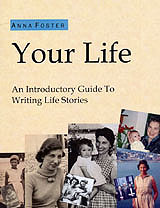
Home > Your Life Writing Guide Contents > Getting Started
3. Getting Started

Collect Your Source Material
Do you have boxes of photographs and letters in the attic?
Before you begin writing, look for any material which may help you to trigger your memories.
Here is a list of useful source materials:
Letters and postcards Letters you receive become your property. Do you wish to quote from them? You are entitled to without permission, but it's diplomatic to get the sender's approval.
Equally, if you wish to quote from a letter that you have sent, you'll need the permission of the recipient.
Diaries and notebooks Full of detail, these are invaluable primary sources. If they are handwritten, do they need to be transcribed?
Make a note of important entries and earmark any sections to quote in full.
Household accounts These can provide snapshots of expenditure and place your life story in a social context. How much was a quarterly fuel bill in 1950, for example, compared to today?
Donít underestimate your readersí fascination with domestic trivia.
Photographs Look at photographs for both their subject and quality. Poor quality photographs can be enhanced these days, so donít reject pictures out of hand.
Use the pictures to jog your memory about events and places, and jot down your recollections.
Don't worry about placing them in chronological order, as you may decide to group your pictures differently.
Make sure you have pictures of all significant members of the family. Start now to track down a picture of anyone who is missing.
Scrapbooks A very useful source of poems, drawings and newspaper articles of achievements at school and at work.
School reports These can be very amusing for readers as they learn that Uncle Ted was lousy at Maths at school yet went on to set up a business, and that Auntie Vivienne was always getting the giggles.
You can quote from a school report or, better still, reproduce one as an illustration.
Greetings cards (e.g., Leaving a Job, Get Well Soon) Always worth a look, to jog your memory about the name of a colleague or an event you attended.
Birth and death announcements Make sure that you get important dates right. If you find one in a newspaper, check what other important events happened on that day, what was in the news and what was being advertised. It all helps put things in context for later generations.
The internet An invaluable resource; you can search for old friends through websites such as Facebook or Friends Reunited; you can double-check dates, names and facts; and you can check your own recollections against the historical record.
Be careful not to plagiarise (copy) text or pictures from websites where you might infringe copyright. Seek permission to reproduce material from the copyright owners.
Organising the Material
Take your time locating these items. As you sift through pictures and letters, ideas for the book will come to you.
Store items in files or boxes, so that your writing/office area isnít overtaken by memorabilia.
Sit down with a pen and notepad and make a list of the items. You donít need much detail, but it will provide a useful checklist once you have begun writing.
Don't let this research period become a throwing-away exercise. You never know what might prove to be useful.
Other source material may come from family or friends. Write to people at an early stage to give them time to find items.
Collecting material is an ongoing process throughout the project. The discovery of a new photograph can be very exciting.
Case study — Barbara Finds Treasures in the Attic
Barbara had been left a manuscript by her Aunt Dorothy when she died. It told the story of Dorothyís life as a working class girl in Leicestershire, employed by various firms of printers.
For a woman with a limited education, the story was surprisingly well written.
The manuscript lay undisturbed in Barbaraís attic for a number of years. When one of her relations enquired after it, Barbara decided it was time to act. She also found a small, leather briefcase filled with old photographs and some of Dorothyís drawings.
Barbara chose about 50 photographs, even though some of were of dubious quality due to their age. She also decided to use all of Dorothyís pen-and-ink illustrations as they had been well preserved and would reproduce well.
Barbara then approached YouByYou to produce the book. We were able to improve the quality of the photographs using digital technology.
During production, Barbara returned to the attic as she had a distant memory that Dorothy had also written some poetry. After rummaging around, she found a small notebook and, inside, about 15 poems. These were inserted into the book at relevant points.
Barbara had 20 paperback copies printed which were given to family members as Christmas presents. Her book came entirely from treasures in the attic.
Do you have any questions from this section? Please email me and I will try to help you.

